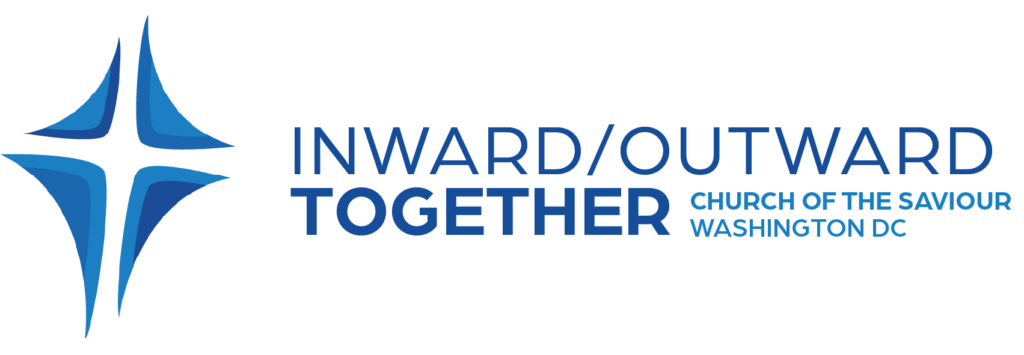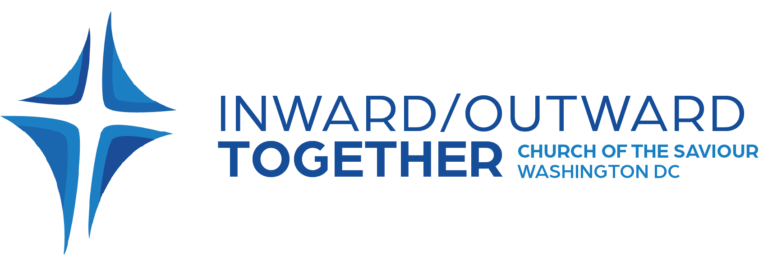Origins
Being part of a disciplined, committed, diverse, ecumenical church was an early dream of N. Gordon Cosby and Mary Campbell Cosby. As children growing up in Lynchburg, VA, during a time of explicit separateness among churches, races and classes, they dreamed of a church that would be unapologetically devoted to the reconciling way of Jesus.
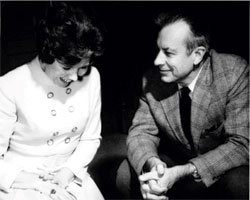
Gordon had a native curiosity and enthusiasm for race relations. When he was a teenager, he asked a rural African-American church who had no minister if he could be their preacher. They said they would give him a try and he preached there for two years. He and his older brother challenged each other to take seriously the evangelistic nature of the gospel, competing to share the Good News with at least one person each day, or pay a fine if they did not. Many nights, Gordon admitted, he would sneak out of the house from his second floor bedroom after curfew and go out in search of some “lost soul” so as to avoid paying the fine. A lonely night watchman down by the railroad got “saved” more than a few times, just to help Gordon out.
During World War II Gordon enlisted as a chaplain and served in the Glider Infantry Unit of the 101st Airborne Division. It was there that he became convinced of the futility of war and it was there that he saw how desperately people need a deeper experience of faith than most churches are structured to offer. He promised God that if he survived the war he would dedicate himself to the pursuit of creating new structures and methods which he hoped would give the church greater integrity and help people enter the depths of discipleship and find the life that sustains.
When he returned to the States in 1946, he and Mary began to act on their dream of a different kind of church. They started by hosting Sunday evening gatherings in restaurants and other borrowed spaces around Washington, DC. Several young people from the Baptist church that Mary’s father pastored in Alexandria formed the beginning nucleus, and in October of 1947 Gordon and Mary, along with seven others, made their first membership commitment as the founding members of The Church of the Saviour. From the beginning, church members sought to embody Christ in intentional ways, welcoming radical diversity and calling all to be ministers through the generous sacrifice of time, energy and resources.

Never owning a traditional church building, the community had a “headquarters” building, a small brownstone mansion near Dupont Circle, for teaching and training members for mission. In 1953 the church was legally incorporated, and although the center of their life and activity was in the city, that same year they felt guided to purchase over 200 acres of meadows and lakes and trees near Germantown, Maryland, where they would learn to rest and play and absorb the rhythms of nature. Recognizing the tendency to mistake busyness for meaningful engagement, Gordon wanted the community to learn to trust the slower rhythms of God. So they began to have silent retreats on the land as well as work parties. In 1956 a lodge was dedicated on a remote part of the land, followed in 1962 by an inn, and Dayspring Silent Retreat Center was born.
The Inward/Outward Journey
Interpreting the call to discipleship as the interweaving of two journeys in community–an inward journey, growing in love of God, self and others, and an outward journey, helping to restore some part of God’s creation–the church became a catalyst for numerous helping ministries. In the late 1950s and early 1960s, in a city segregated by race and economic class, Gordon Cosby encouraged members to consider how they might respond together to particular areas of brokenness that cried out for healing. Small mission groups began to form, dedicated to various needs in the city and beyond.
One of the first set an impossible goal: to shut down the District institution called Junior Village where children were being warehoused for want of private foster or adoptive homes. The 30 or 40 church members began to visit and befriend the children, serving their needs; they canvassed neighborhoods to find homes for them, and took some into their own homes. Out of these efforts they started a non-profit organization in 1965 to carry the work forward, called For Love of Children, and in 1973 Junior Village was closed.
One winter evening in 1959, Gordon and Mary were invited to speak at a New England church which turned out to be rather cold and unfriendly. They discovered that their room for the night was above a rowdy tavern where the sounds of revelry continued long into the night. The next morning, over breakfast in a small inviting café, they commented that both the bar and the café seemed friendlier and more like the kinds of places Jesus would want to hang out in than the church had been.
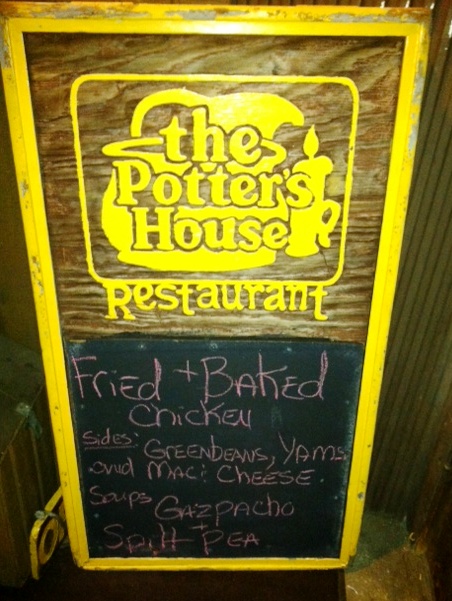
When they arrived back in Washington, they shared the experience with their church community, and the seed of a Call was planted. The Church of the Saviour started searching for a public space that would be conducive to lively exchange and conversation across differences, where people could express strong opinions and learn to lovingly disagree. In this place the traditional boundaries between sacred and secular would dissolve, and people could talk about God as freely as they talked about other aspects of their lives. In 1960, the church found space at 1658 Columbia Road NW and dedicated the work of the Potter’s House, believed to be the first coffee house in Washington, DC.
Inspired by the vision of the Rev. Dr. Martin Luther King, Jr., and having participated in the 1963 March on Washington and the historic 1965 march from Selma to Montgomery, Alabama, Gordon began to challenge his small, racially mixed congregation to do even more to cross boundaries and break down walls of separation in their own neighborhoods and city. He heard Christ calling them to take bolder action to bring into being the beloved community that Martin Luther King was calling forth.
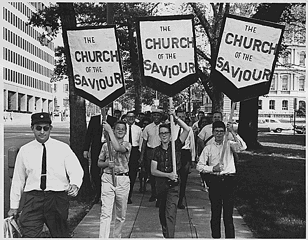
When Rev. King was assassinated in 1968, and riots broke out in the city, the Potter’s House became a place of refuge and hope, a place where church members and neighborhood residents could continue to build bridges of love and trust across barriers of distrust and fear. It was at the Potter’s House that people began to strategize for the development of ministries that would respond in specific ways to the needs of a hurting city. During the 1970s and 1980s, more than a dozen non-profit ministry organizations were organized by a congregation of about 120 members and their friends.
In 1976 The Church of the Saviour became a “scattered church” of small faith communities, and in 1995 most of these communities became independently incorporated churches.
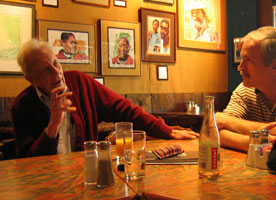
Sensing that the deepest journeys are full of paradox, Gordon Cosby taught through his sermons (now available for listening) that we must, as Walt Whitman said, be “living always–always dying.” Over the years Gordon urged the churches to listen deeply, to act boldly on the guidance that was being given, to build when God said build, and to let go–even die–when God said let go. In this way, he believed, a local expression of the church lives Jesus’ journey, growing into the likeness of Christ in whom all are one. On March 20, 2013, the Church of the Saviour lost its patriarch, when at the age of 95, Gordon Cosby passed from this earthly realm he loved so much into the fullness of God’s Realm. His wife, Mary Campbell Cosby, died July 3, 2016 at the age of 93.
The New, New, New Land
The churches which have their roots in the vision of Jesus and the early Christian communities, and were born from Gordon and Mary’s childhood dream, continue to seek to be authentic expressions of Christ’s Body, with structures and processes that serve God’s vision for them now. Members still seek mutual liberation and connection across the divisions of race, economic class, gender, age, sexual orientation, political affiliation and other perceived differences, and from these points of diversity they share life with one another, tell their stories, unmask their dependence on a societal system that keeps people alienated, and together take bold steps toward healing and justice.
Being with others on a deepening inward and outward journey, listening for Spirited callings and creating structures to support and embody the dreams that are given–these are at the heart of “the way” that is the Church of the Saviour. It is an organic way of being Church, always seeking to embody more fully the nature of Jesus Christ, who brings good news to the poor, release to the captives, recovery of sight to the blind, freedom to the oppressed–proclaiming an era of Jubilee for all God’s family.
